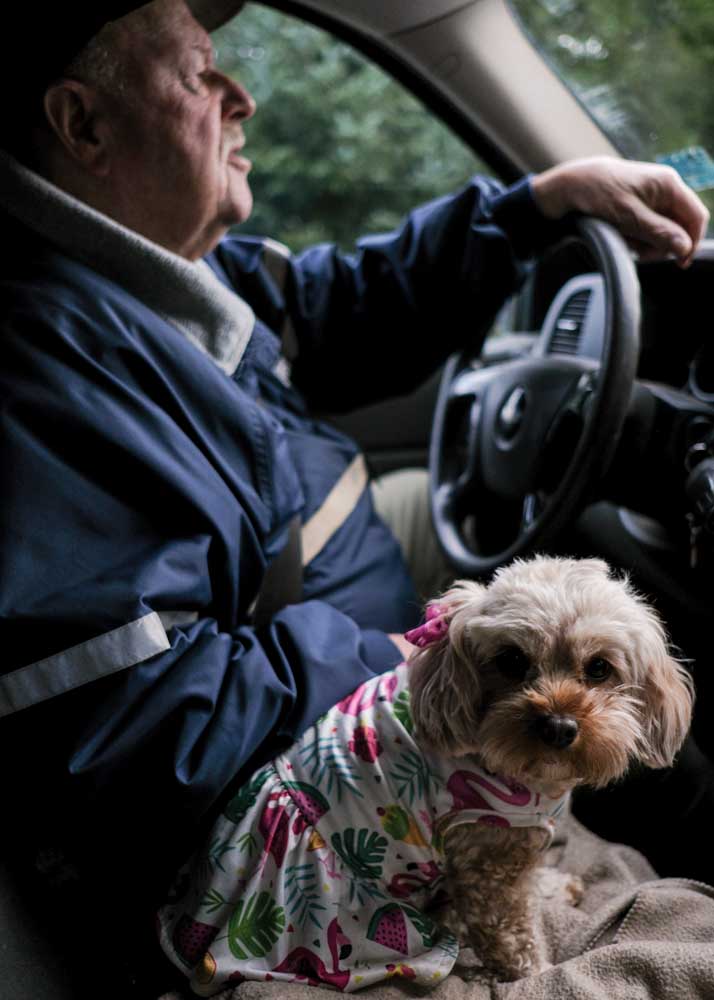Conserve or harvest: Balancing rural economies with preserving old forests
Published 2:45 pm Thursday, March 27, 2025

- Wahkiakum County Commissioner Dan Cothren drives his pickup, accompanied by Daisy.
The “Super Truckin Sorts timber sale” is three miles east of Cathlamet, on state forest land — lands that counties acquired through tax foreclosures, before deeding them over to the state for management. It comprises 100 acres of century-old hemlock and, should it survive a legal challenge from an environmental group, is projected to net just shy of $1.8 million for Wahkiakum County’s general fund.
Trending
The “Auger In timber sale” is two miles north of Pluvius on state trust land — federally granted lands managed by the state for various trust beneficiaries. The harvestable portion of the sale comprises 64 acres dominated by Douglas-fir, with an origin date of 1914 and an appraisal value of $695,000. About 80% of the revenue would go into the common school trust.
Both stands were deemed by Washington Department of Natural Resources foresters to have reached the “Maturation II” stage of development, which, according to the 100-page guide that helps the agency identify mature and old forests, immediately precedes the first stage of true old-growth.
Both stands were slated to be auctioned soon. But as of now, only “Super Truckin Sorts” will be put up for bids, a legal appeal notwithstanding. “Auger In,” along with 22 other timber sales that have reached the Maturation II stage, has been paused for at least six months, in one of Dave Upthegrove’s first acts as commissioner of public lands.
Trending
‘My interest… is that we’re able to generate wood products and have a strong, healthy wood products industry for generations to come. Part of that involves protecting the biodiversity of our forests.’
Dave Upthegrove, commissioner of public lands
Whether intended or not, the differing outcomes for these stands on paper is indicative of a reality on the ground: not every patch of aging trees is the same, or representative of the same balance of ecological and economic value.
“I consider the naturally developed, mature forests to be a very important resource, just as the old-growth forests are… because the natural forests — forests that have come in after a wildfire, a blow-down, things like that — had their legacies, and so they they were complete, in terms of their evolution,” says Dr. Jerry Franklin, the esteemed forester and ecologist whose many decades of research contributed significantly to what we now understand about old-growth ecology in the Pacific Northwest. “We aren’t creating forests like that anymore, and because they are very complete… I feel that they ought to be conserved.”
“A lot of what they’re calling ‘legacy forests’ are areas that were logged, but in the old days they were very sloppily logged,” Franklin continues. “I think it’s sort of up to society to decide what it wants to do with those.”
Should Commissioner Upthegrove achieve what he hopes to by the end of the six-month pause, the agency he leads may very well emerge with a more refined answer to the question of what it wants to do with all of its aging forests, and the ability to determine the fate of any given patch of old trees with greater intention and consistency.
Pausing, not stopping
The first thing Upthegrove wants Washingtonians to understand about the pause is that it isn’t a “set-aside.”
“I’m not… proposing or pursuing policies that take land out of our harvestable land base and put them into preservation. I’m looking at changing when we harvest parcels over here,” he says, pointing at one half of a circle doodled on a piece of printer paper — the harvestable half.
“What it means is some of [the sales] the previous [state lands] administration had been planning on harvesting within a year or two may likely end up deferred until we hit those habitat goals, and we will pull forward as soon as we can other parcels and harvesting,” he adds.
The habitat goals Upthegrove is referring to are delineated in the state’s Habitat Conservation Plan. They project that by the end of the century, 10-15% of state forests in each of five Western Washington planning units will be “older,” “structurally complex,” or “fully functional,” depending on which policy document one reads.
The seeming interchangeability and subjectivity of these terms is partly responsible for the controversy surrounding so-called “legacy forests,” not to mention the uncertainty about whether the 10-15% target constitutes a legal obligation in the first place. A closer look at the relevant stand-development guides offers some clarity though. “Older” and “structurally complex” are the broader terms, encapsulating Maturation II stands and generally all stands that are at least a century old. The term “fully functional” refers to a narrower cohort of stands that originated at least a century and a half ago. For all intents and purposes, these fully functional stands may be thought of as old-growth.
With the pause now in effect, it isn’t clear exactly where in that half-century window the line will be drawn between stands that can be cut and those that ought to be left standing. But Upthegrove’s intention is clear: for now, he will expand the latter category, thereby accelerating the pace at which the DNR moves towards the older forest target, while making up for the volume elsewhere so as to maintain timber revenue for counties and trust beneficiaries. In his mind, letting forests age into greater ecological complexity and sustaining the economic viability of timber-dependent communities aren’t just simultaneously achievable goals. They’re mutually reinforcing.
“My interest… is that we’re able to generate wood products and have a strong, healthy wood products industry for generations to come,” he says. “Part of that involves protecting the biodiversity of our forests. Every definition of sustainability means you’re sustaining the biodiversity — the plant and animal life — and an important part of that is making sure that across our landscape we have a mix of forest ages and types.”
The six-month pause is a first step towards achieving this vision — an accounting period of sorts, that will be backed up by a combination of modeling and number crunching, and boots-on-the-ground surveying. It’s an opportunity for the DNR to get a better idea of how much structurally complex forest exists on the landscape, and where, and develop the criteria needed to determine whether any given stand should be prioritized for the older forest target or harvest.
“For lack of a better term,” says Upthegrove, posing the common sense question he wants to answer in these six months, “what forests are we talking about?”
Competing interests
Unsurprisingly, the commissioner will continue to face pressure from all sides, as different interest groups seek to influence how the DNR answers that question.
Environmental groups such as the Legacy Forest Defense Coalition, which filed the appeal against the Super Truckin Sorts sale, are skeptical of Upthegrove’s current commitment to maintaining the net balance of conserved and harvestable acres. Whereas the commissioner envisions a portion of the stands that will contribute to the older forest target ultimately remaining within — and indeed, rotating throughout — the harvestable land base, activists would like to see most if not all of those acres squarely within the conserved half of state lands. What the commissioner doesn’t insist on setting aside in perpetuity, much of the environmental community does.
“At that point you’re going to have trees that are oversized for mills, and it wouldn’t make sense to move that around… you’d rather just keep those areas protected,” says Josh Wright, an activist with LFDC, regarding fully functional forests originating at least a century and a half ago.
“That isn’t to say structurally complex forests… wouldn’t be logged… if they had a lot more of those on the landscape and were [already] meeting their fully functional old-forest targets,” he continues. “But that 10 to 15% target, in our minds, should definitely be protected in the long run.”
Will they budge?
This discrepancy in the commissioner’s and the environmental community’s positions may be one of degree rather than underlying philosophy. But the mere fact that it exists is troubling to somebody like Wakhiakum County Commissioner Dan Cothren, who has little faith in most environmental activists’ willingness to budge on their demands.
“He might have a good idea — I might even agree with his idea,” says Cothren of Upthegrove’s vision of a shifting mosaic of forest age classes and allowing some of the state’s older forests to rotate throughout its harvestable base. “But you’re going to get challenged on that idea, and it’s the people that put you in there.”
‘He needs to understand — he’s held these timber sales up, but if he’d held [Super Truckin Sorts] up… we’d be looking at layoffs.’
Dan Cothren, Wahkiakum County commissioner
Furthermore, should the result of the six-month pause be policies that would have had a sale like Super Truckin Sorts deferred, Cothren and others whose communities and livelihoods depend on timber revenue will have immediate reasons to push back against the state.
“He needs to understand — he’s held these timber sales up, but if he’d held [Super Truckin Sorts] up… we’d be looking at layoffs,” says Cothren of Wahkiakum County’s finances. “We’re kind of payday-to-payday for the county, because we have to borrow money from our reserve funds to make it. When we have a timber sale, we can pay it back.”
“But it gets to a point where you borrow, and you prolong a timber sale, and you just can’t make it up,” he continues. “So it really affects us big time, and that’s something he needs to understand.”
Compromise
Ultimately, a probable outcome of the six-month pause is a sort of compromise between the preferences of environmental groups and timber-dependent communities: some, but not all of the structurally complex forest within the harvestable land base will be deferred, and some will be green-lighted for logging. The net balance between harvestable and preserved acres seems unlikely to change, and the 10-15% older forest target will probably be achieved with a combination of permanently set-aside forests, and cuttable forests managed on an extended rotation.
“I imagine… that [the commissioner’s] policy people will remind him that there are some of those place on the landscape that contribute to the 10 to 15% that are part of HCP obligations that can’t move,” says Paula Swedeen, policy director for Conservation Northwest.
“Once they do reach that 10 to 15%, some of it should go on a rotation, but that rotation should be driven not by going from a structurally complex forest to a 50-year rotation plantation,” she continues. “It should be put back in the cycle of being managed to eventually grow back into the stuff.”
Talking timber
Cothren is prepared to have some disagreements with the state’s ultimate course of action. But even so, he trusts that the commissioner understands the plight of a small, timber-dependent communities like Wahkiakum County, and the way that environmental restrictions can impact them disproportionately.
He and Pacific County Commissioner Lisa Olsen met with Upthegrove at the office of the DNR’s Pacific Cascade Region in Castle Rock on March 17 to, as he puts it, “talk timber.” And that timber talk left him feeling highly optimistic.
“I guess I have to see what he gets out of… holding these timber sales up for six months… I think there might be some things that we might not agree on,” Cothren says. “But on the whole I just feel that he’s real receptive and he understands, so that’s key.”
And that’s a pleasant surprise for the county commissioner and retired timber faller, who isn’t shy about his skepticism of urban bureaucrats and what he sees as their perpetual misunderstanding of rural needs and lifestyle.
“I think he has some feelings for small, rural counties,” says Cothren. “I think he’s a person I can work with.”









